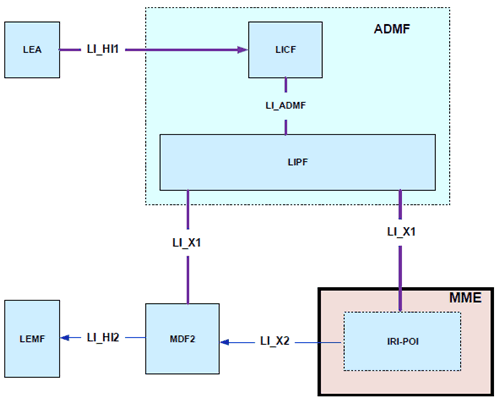Content for TS 33.127 Word version: 18.7.0
0…
5…
5.4…
5.6…
5.7…
6…
6.2.2…
6.2.3…
6.2.5…
6.3…
6.3.3…
6.3.4…
6.4…
7…
7.3…
7.4…
7.4.7…
7.5…
7.6…
7.7…
7.8…
7.9…
7.10…
7.11…
7.12…
7.13…
7.14…
7.15…
7.16…
8…
A…
A.2…
A.3…
A.4…
B…
D…
E…
6.3 EPC
6.3.1 General
6.3.2 LI at the MME
6.3.2.1 Architecture
6.3.2.2 Target identities
6.3.2.3 IRI events
6.3.2.3.1 Option A
6.3.2.3.2 Option B
6.3.2.4 Common IRI parameters
6.3.2.5 Specific IRI parameters
6.3.2.5.1 Option A
6.3.2.5.2 Option B
6.3.2.6 Network topologies
...
...
6.3 EPC p. 58
6.3.1 General p. 58
The present document specifies three options for EPC interception capabilities:
- Option A: Perform LI on the events specified in the current document in clauses 6.3.2.3.1, 6.3.3.3 and 6.3.4.3 using the capabilities specified below for stage 2 and in TS 33.128 for stage 3.
- Option B: Perform LI on the events specified in clauses 12 and 18.2.4 of TS 33.107 using the capabilities specified below in the present document for stage 2 and in TS 33.128 for stage 3.
- Option C: Use TS 33.107 and TS 33.108 natively as defined in those documents.
6.3.2 LI at the MME p. 59
6.3.2.1 Architecture p. 59
In the EPC network, the MME handles the mobility management and connection management as specified in TS 23.401. The MME shall have LI capabilities to generate the target UE's network access, registration and connection management related xIRI. Extending the generic LI architecture presented in clause 5, Figure 6.3-1 below gives a reference point representation of the LI architecture with MME as a CP Network Element providing the IRI-POI functions.

The LICF present in the ADMF receives the warrant from an LEA, derives the intercept information from the warrant and provides the same to the LIPF.
The LIPF present in the ADMF provisions the IRI-POI (over LI_X1) present in the MME and the MDF2.
The IRI-POI present in the MME detects the target UE's access and mobility related functions (network access, registration and connection management), generates and delivers the xIRI to the MDF2 over LI_X2. The MDF2 delivers the IRI messages as part of the Interception Product to the LEMF over LI_HI2.
6.3.2.2 Target identities p. 60
The LIPF provisions the IRI-POI present in the MME with the following target identities:
- IMSI.
- MSISDN.
- IMEI.
6.3.2.3 IRI events p. 60
6.3.2.3.1 Option A p. 60
The IRI-POI present in the MME shall generate xIRI, when it detects the following specific events or information:
- Attach.
- Detach.
- Tracking Area/EPS Location Update.
- Start of interception with EPS attached UE.
- Unsuccessful communication related attempt.
- Identifier association.
- Positioning info transfer.
- Handover.
- Trace.
- Service accept.
- network-based or network-assisted positioning requests, responses or reports related to a target UE are being exchanged between E-SMSC and eNB via the MME.
- UE-based or UE-assisted positioning requests, responses or reports related to a target UE are being exchanged between E-SMLC and the target UE via the MME.
6.3.2.3.2 Option B p. 61
The IRI-POI present in the MME shall generate xIRI, when it detects the applicable events specified in TS 33.107.
In addition to the events specified in TS 33.107 the MME shall generate xIRI, when it detects the following additional event:
- Identifier association.
- Handover.
- Trace.
- Service accept.
6.3.2.4 Common IRI parameters p. 62
The list of xIRI parameters is specified in TS 33.128. All xIRI shall include the following:
- Target identity.
- Time stamp.
- Location information.
- Correlation information.
6.3.2.5 Specific IRI parameters p. 62
6.3.2.5.1 Option A p. 62
The list of parameters in each xIRI are defined in TS 33.128. The following give a summary.
The attach xIRI shall include the following:
- Attach type information.
- Access type information.
- HeNB information.
- Detach Direction.
- Detach type information.
- HeNB information.
- Location of the target (see clause 7.3).
- HeNB information.
- Attach type information.
- Access type information.
- PDN connection information.
- Rejected type of communication attempt.
- Access type information.
- Failure reason.
- IMSI.
- IMEI.
- Temporary identifier association (i.e. GUTI).
- Association change type indication.
- Handover type and reason.
- Radio related information.
- UE capability information.
- Trace related information.
- UE policies.
- Service request related information.
- Service accept related information.
6.3.2.5.2 Option B p. 63
The list of parameters in each xIRI are defined in TS 33.128, for events which are imported from clause 12.2.1.2 of TS 33.107.
The identifier association xIRI shall include the following:
- IMSI.
- IMEI.
- Temporary identifier association (i.e. GUTI).
- Association change type indication.
- Handover type and reason.
- Radio related information.
- UE capability information.
- Trace related information.
- UE policies.
- Service request related information.
- Service accept related information.
6.3.2.6 Network topologies p. 63
The MME shall provide the IRI-POI functions in the following network topology cases:
- Non-roaming case.
- Roaming case, in VPLMN.